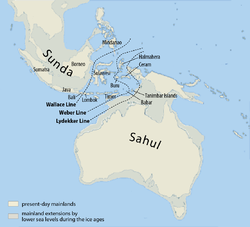Australasian realm
The Australasian zone is an ecological region which fits the geographic region of Australasia. That means Australia, New Guinea and neighbouring islands. The northern boundary is the Wallace Line.


The ecozone includes Australia, the island of New Guinea (including Papua New Guinea and the Indonesian province of Papua).
The smaller islands include the eastern part of the Indonesian archipelago, including the island of Sulawesi, the Moluccan islands (the Indonesian provinces of Maluku and North Maluku) and islands of Lombok, Sumbawa, Sumba, Flores, and Timor, often known as the Lesser Sundas.
The Australasian ecozone also includes several Pacific island groups, including the Bismarck Archipelago, Vanuatu, the Solomon Islands, and New Caledonia. New Zealand and its surrounding islands are a distinctive sub-region of the Australasian ecozone. The rest of Indonesia is part of the Indomalayan ecozone. [1]
The Australasian continental plate was once attached to Antarctica as part of the Gondwana supercontinent. The peculiarity of its flora and fauna is due to its long separation from the rest of the world. Apart from some birds, and until recent introductions by man, the native life had been undisturbed by invasions. The ecozone has the only two living monotremes, and has no native eutherian mammals.
Almost all its native mammals (except the two monotremes) are marsupials. The indisputable remains of Australian placental mammals started from the Miocene, when Australia moved closer to Indonesia. After 15 million years ago (mya) bats appeared in the fossil record, and after 5-10 mya rodents did, and 1 mya rats arrived. This information is based on the fossil record. Several thousand years ago, man brought the dingo, and 200 years ago many more species. This information applies to Australia. The fauna of New Zealand, and the Pacific islands shows a different pattern. There the migrations from the Indomalayan ecozone mostly did not arrive.
Alfred Russell Wallace found the dividing line between the Australasian ecozone and the rest of the world. It runs between the islands of Lombok (Australasia) and Bali (Indomalaya).